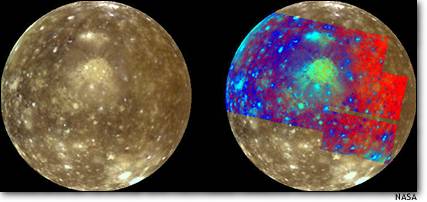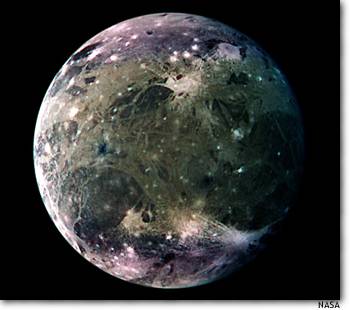 |
||
| Callisto is considered the most cratered celestial body in the solar system. The false-color overlay at right exaggerates the moon's surface features, including the Valhalla impact structure near the center of the disk. |
| A comet's trail |
 |
||
| This chain of 13 craters on Ganymede is thought to have been caused by a comet that broke up into separate fragments just as it was about to hit the surface. |
| Ganymede's dark face |
 |
||
| Colors are enhanced in this view of Ganymede's trailing hemisphere, highlighting the moon's polar caps. The violet color indicates where small particles of frost may be scattering light on the blue end of the spectrum. |
 |
A blast at Io This image of Io, thought to be the solar system's most volcanically active world, shows the plumes of two eruptions. One plume can be seen at the very edge of the disk, the other is puffing up from the dark volcanic ring near the center of the disk. |
| This is the Spot |
 |
||
| A true-color picture captures the subtle shadings of Jupiter's Great Red Spot, a massive, long-lived storm system in the planet's thick atmosphere. |
| Cloudy weather |
 |
||
| The mosaic at left shows the true colors of the cloud patterns in Jupiter's northern hemisphere. The rendition at right uses false colors to represent the height and thickness of the cloud cover. |
| A big splash on Europa |
 |
||
| A computer-generated perspective view shows the Pwyll impact crater on Europa, an ice-covered moon of Jupiter. The heights are exaggerated, but the central peak indicates that the crater may have been modified shortly after its formation by the flow of underlying warm ice. |
| Crazy quilt |
 |
||
| The thin crust of Europa's Conamara region is criss-crossed by craters, cracks and lines - indicating that the surface ice was repeatedly disrupted. The colors, which are enhanced in this view, show where light ice crystals and dark contaminants have settled onto the surface. |